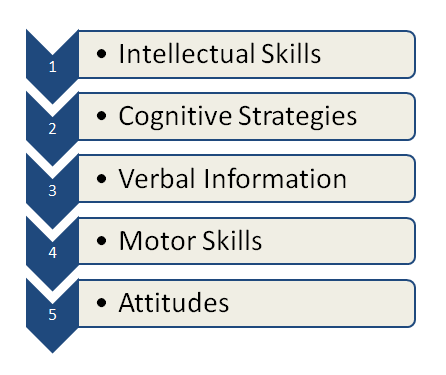Robert Gagné’s Taxonomy of Learning
Gagne classified learning outcomes into five major categories: verbal information, intellectual skills, cognitive strategies, motor skills and attitudes.
What is learning to Gagné?
- As outlined in his 9-events of instruction, Gagne believed that learning was ongoing and built continuously on prior knowledge. Humans developed intellectually based on their physical capacity to do so.
- It is through ongoing learning that a human becomes a valuable member of society.
- Even if the input is the same, the learning outcome varies. Human behavior is dependent not only on the external environment, but the cognitive process itself.
See also: Lev Vygotsky – Sociocultural Theory of Cognitive Development
Based on Gagné’s ideas, specific assumptions have been made about his work:
- Learning requires differentiated instruction and various levels of support. As each student has unique prior knowledge, the lessons must always address the complexity and the processing level of the learner. Different strategies will be required to achieve different learning goals.
- Both internal and external stimuli affect the conditions of learning. Just as new abilities are processed internally, the classroom conditions should support the learning process. The learning hierarchy outlines the order of instruction as well as what skills should be learned.
See also: How To Design A Course

In 1985, Gagné began to classify results into specific groups. He stated that the five learning outcomes fell into three particular domains: the cognitive domain, the psychomotor domain, and the affective domain. He outlined five categories of learning, which are as follows:
- intellectual skills (cognitive domain)
- cognitive strategy (cognitive domain)
- verbal information (cognitive domain)
- motor skills (psychomotor domain)
- attitude (affective domain).
See also: Bloom’s taxonomy
1. Intellectual skills
As the first category in the cognitive domain, intellectual skills outline how to follow procedures to get things done. There are five different levels of learning within the intellectual skills category: discrimination, concrete concept, defined concept, rule, and problem-solving.
Discrimination: the capacity to classify objects by one or more of their characteristics. An example would be to differentiate between octopuses/squids or alligators/crocodiles.
- This skill is should be repeatedly practiced.
Concrete concept: the capacity to identify objects based one or more of their unique characteristics, such as the shape or color. An example would be to identify a tomato as a vegetable or a fruit. This concept is more challenging than discrimination because the learner must outline the main properties of the object. Following the idea of hierarchy in Bloom’s Taxonomy, a learner must learn discrimination before they learn concrete concepts.
- This skill can be practiced by presenting a variety of unrelated objects to the students and asking them specific questions about each.
Defined concept: the capacity to demonstrate understanding about an abstract object or event. This skill requires the ability to explain more than the textbook definition of a concept. An example of abstract idea to define would be a family or a community. While there may be some concrete concepts in the description, the student would explain the idea in relation to their own experiences.
- This skill can be practiced by asking students to outline all of the information they know about a concept, and then have them draw conclusions between the ideas. They could also watch a video or a demonstration of the concept in question.
Rule: the capacity to make connections between concepts and objects. This may include how to play a game, how to do division, or how to create a sentence that includes all necessary parts.
- This skill can be practiced by having each student recall the concepts that create the rule for each idea. The instructor should utilize all prompts and strategies in order to clearly share each rule with the students.
Problem-solving: the capacity to integrate multiple rules to find a solution.
- This skill can be practiced by reviewing information that is relevant to the problem. The instructor may also prompt them to discover new rules that may help them engage in a solution.
See also: Problem-Based Learning (PBL)
2. Cognitive strategy
The second type of cognitive skill is a cognitive strategy. There are a few strategies for learning as well as for thinking, which are also called metacognitive strategies. Learning strategies include:
- rehearsal, which involves copying and underlining information or reading it out loud
- elaboration, where the student takes notes, paraphrases ideas, summarizes information and answers questions, and
- organizing, which includes creating concept maps and arranging ideas in a meaningful way.
Metacognitive strategies (thinking) include:
- setting goals
- tracking progress
- modifying strategies
These strategies help students control their everyday stress, manage their time effectively, and focus their attention on the task at hand.
See also: Andragogy Theory – Malcolm Knowles
3. Verbal information
The third category in the cognitive domain, verbal information, is taught using different techniques to aid in memory recall. Using imagery and other mnemonic strategies helps students make connections with the information and remember it more easily. As verbal information is often a lot of facts, places and names, the use of learning strategies is meant to provide cues to one’s memory. Organizing, elaborating and rehearsing are all ways to assist in learning declarative knowledge.
See also: Social Learning Theory: Albert Bandura
4. Motor skills
The only category in the psychomotor domain, motor skills are physical actions that are assessed in complex performances such as skiing, dancing, skateboarding, or even writing with a pencil. These movements are evaluated on accuracy, smoothness, speed, or force. Motor skills are also known as psychomotor skills due to the coordinated response required.
Psychomotor skills have their own sub skills, which are also called part skills. Part skills are taught with clear instructions such as diagrams, checklists and even pictures to help the learner move in the right direction. It is important to note that part skills are best learned by continuous practice.
5. Attitude
Attitude is found in the affective domain due to its unique state. It is often challenging to measure attitude, as each individual must declare their own thoughts. Self-reported questionnaires would be an example of how we can assess the attitudes of learners. Although it is an internal state of mine, attitude can be observed in one’s own personal choices or actions.
There must be a conscious effort in order to change one’s attitude and they must be willing to do so. Using a mentor or role model has been an effective way of changing one’s attitude. The student is first asked to remember a time where the negative attitude applied. Then, a mentor demonstrates or re-enacts the desired response for the given situation. The mentor must be valued by the student and must also communicate the positive outcome achieved when the new attitude is applied. Reinforcements or a conditioned response can be used to promote the desired attitude.
See also: Using Bloom’s Taxonomy to Write Effective Learning Objectives: The ABCD Approach

